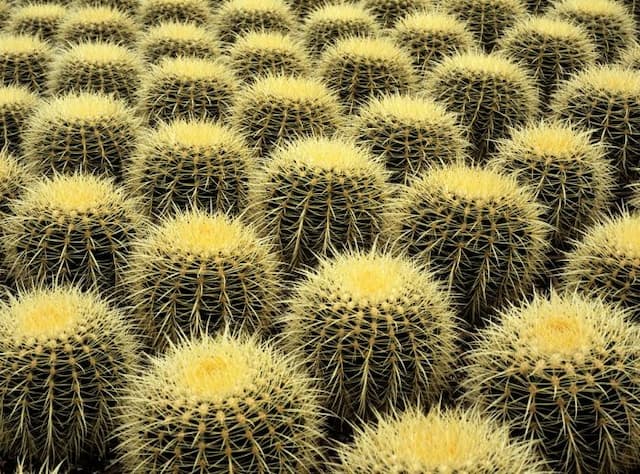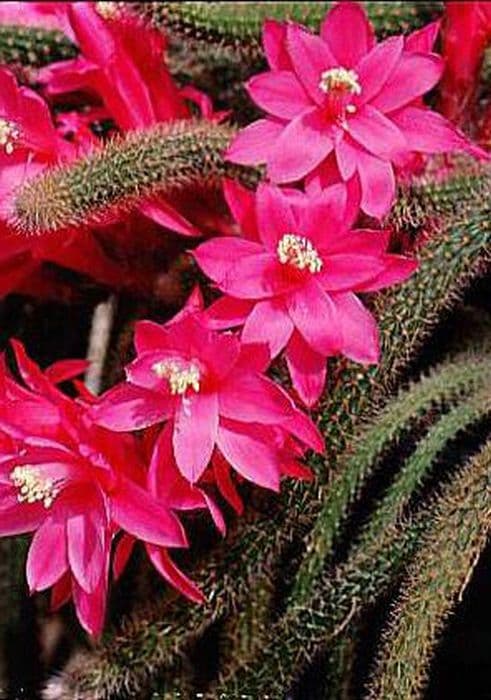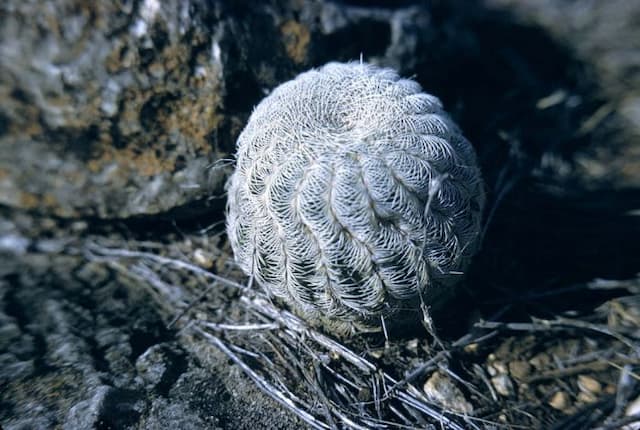Old Man Cactus Pilosocereus leucocephalus

ABOUT
The columnar P. leucocephalus cactus hails from Central America. Distinctive for the silky growth surrounding its spines, it has earned the nickname, woolly torch. The ribbed trunks may be branched and can reach 6m.Older plants will bear showy pale pink flowers with lemon throats on their crowns. In the wild these are principally bat pollinated
About this plant
 Names
NamesFamily
Cactaceae
Synonyms
Old Man Cactus, Old Man of Mexico, Woolly Torch
Common names
Cephalocereus leucocephalus, Pilocereus leucocephalus, Pseudopilocereus leucocephalus.
 Characteristics
CharacteristicsLife cycle
Perennials
Foliage type
Evergreen
Color of leaves
Varies
Flower color
White
Height
20 feet (6 meters)
Spread
4 feet (1.2 meters)
Plant type
Cactus
Hardiness zones
9
Native area
Mexico
Benefits
 General Benefits
General Benefits- Ornamental Value: Pilosocereus leucocephalus, commonly known as Old Man's Head Cactus, is prized for its striking blue-green columnar stems and white cephalium that add aesthetic value to gardens and indoor spaces.
- Drought Tolerance: As a cactus, the Old Man's Head Cactus is extremely drought-resistant, requiring minimal watering and surviving in dry conditions where other plants might perish.
- Low Maintenance: This plant requires very little upkeep, making it ideal for people who want a beautiful garden or indoor plant without the high maintenance.
- Habitat for Wildlife: The flowers and fruits of the Old Man's Head Cactus can provide food sources for birds, bees, and other pollinators in its native habitat.
- Erosion Control: By establishing itself in harsh environments, Pilosocereus leucocephalus can help in preventing soil erosion with its root system.
- Educational Interest: It can serve as an educational specimen for those interested in botany, specifically in the study of cacti and their adaptations to arid environments.
 Medical Properties
Medical Properties- This plant is not used for medical purposes.
 Air-purifying Qualities
Air-purifying QualitiesThis plant is not specifically known for air purifying qualities.
 Other Uses
Other Uses- Pilosocereus leucocephalus, commonly known as the Old Man Cactus, has been used as a living fence to demarcate property boundaries and protect land from animals due to its dense and spiny nature.
- Its wood, once dried, serves as a material for building rural furniture and small craft items among indigenous and local communities, providing a sustainable resource.
- The cactus can be employed in desert landscaping to attract biodiversity; its flowers are known for drawing hummingbirds and other pollinators.
- Stems of the Old Man Cactus have been used in the preparation of traditional dyes by some indigenous groups, tapping into the plant's natural pigments.
- The thick, fleshy stems are sometimes carved and sold as a form of natural art known as "cactus sculpture," taking advantage of its unique texture and form.
- The fibers from the cactus have been traditionally used to make ropes and twine by indigenous peoples in areas where the cactus grows.
- In some cultures, the Old Man Cactus has a symbolic value and is gifted as a representation of protection and longevity, aligning with the cactus's own hardy nature.
- The dead stems of the cactus can sometimes be used as fuel for firewood, providing a burnable material in resource-scarce desert environments.
- Segments of the Old Man Cactus, when hollowed out, can serve as a natural container or planter for other plants, embracing a sustainable gardening practice.
- Young stems of the cactus are occasionally used as a food source for livestock in periods of drought, providing emergency fodder.
Interesting Facts
 Feng Shui
Feng ShuiThe Old Man Cactus is not used in Feng Shui practice.
 Zodiac Sign Compitability
Zodiac Sign CompitabilityThe Old Man Cactus is not used in astrology practice.
 Plant Symbolism
Plant Symbolism- Resilience: As a species of cactus, the Old Man Cactus is well-adapted to survive in harsh, arid environments, symbolizing the ability to endure and thrive in difficult conditions.
- Protection: The Old Man Cactus has a thick, spiny exterior that serves as defense against predators, representing guarding and safety.
- Longevity: Cacti are known for their long lifespans, with the Old Man Cactus potentially living for many decades, thus denoting persistence and the passage of time.
- Conservation: Native to Mexico and parts of Central America, the Old Man Cactus is sometimes used in traditional medicine, symbolizing the importance of preserving plants for their cultural and therapeutic values.
- Water Retention: Its capacity to store water in dry climates serves as a symbol for resourcefulness and adaptability.
- Isolation: The fact that cacti often stand alone in desolate landscapes can represent solitude or self-reliance.
 Water
WaterThe Old Man Cactus should be watered sparingly as it is drought-tolerant, ideally when the soil has completely dried out. During active growth in warmer months, watering once every two weeks with about 8 to 12 ounces of water should be sufficient. Decrease watering to once every four to six weeks during the cooler months to prevent rot. It’s important to ensure the pot has good drainage to avoid waterlogging. Over-watering can lead to root rot, so it’s better to err on the side of underwatering with this desert native.
 Light
LightThe Old Man Cactus prefers bright, direct sunlight for optimal growth. It should be placed in a spot where it receives at least 6 to 8 hours of sunlight a day, such as a south-facing window or an unobstructed outdoor location. Too little light can lead to etiolation, where the cactus becomes stretched and disfigured, while too much direct light in the hottest part of the day can cause sunburn.
 Temperature
TemperatureThe Old Man Cactus thrives in temperatures between 70°F and 100°F but can tolerate a minimum of 50°F. It should not be exposed to temperatures below freezing as it can suffer from cold damage. The ideal conditions would be those mimicking its natural habitat, which involves warm daytime temperatures with cooler nights.
 Pruning
PruningPruning of the Old Man Cactus is not often required, but it may be necessary to remove any dead or damaged spines to maintain its appearance and health. The best time for pruning would be in the early spring before new growth begins. Pruning should be done sparingly and with care, using clean, sharp tools to avoid injury to the cactus.
 Cleaning
CleaningAs needed
 Soil
SoilThe Old Man Cactus thrives in a well-draining soil mix with coarse sand or perlite and peat or coir to retain some moisture. The ideal pH should be slightly acidic to neutral, ranging from 6.0 to 7.5. A cactus mix blended with additional perlite or pumice enhances drainage, reducing the risk of root rot.
 Repotting
RepottingOld Man Cactus should be repotted every two to three years, or when it outgrows its current pot. It is best to repot during the warmer season, which allows the plant to quickly re-establish in its new container.
 Humidity & Misting
Humidity & MistingThe Old Man Cactus prefers a dry environment with low humidity levels. It is well-suited to typical indoor humidity conditions and does not require any special humidity adjustments.
 Suitable locations
Suitable locationsIndoor
Old Man Cactus needs bright light, low humidity, and infrequent watering.
Outdoor
Place Old Man Cactus in full sun with good drainage.
Hardiness zone
9-11 USDA
 Life cycle
Life cyclePilosocereus leucocephalus, commonly known as the Old Man Cactus, begins its life cycle as a seed, which germinates in well-drained soil with warmth and adequate moisture. Upon successful germination, a small cactus seedling emerges and starts to exhibit slow growth, forming a columnar stem with ribs and spines. As it matures, the Old Man Cactus develops a hairy cap or cephalium made of wool and bristles, which is where flower buds will form. Flowering occurs usually at night, with large, white, funnel-shaped flowers that are pollinated by nocturnal pollinators such as bats or moths. Once pollinated, the flowers produce fleshy fruits that contain seeds, thus completing the reproductive cycle. Over the years, the cactus continues to grow taller, potentially reaching several meters in height, and may produce offsets or "pups" around its base, propagating asexually.
 Propogation
PropogationPropogation time
Spring-Early Summer
The Blue Columnar Cactus, or Pilosocereus leucocephalus, can be propagated effectively using stem cuttings. The best time to take cuttings for propagation is during the warmer months, which is late spring through early summer, when the plant is actively growing. To propagate by cuttings, a healthy, disease-free branch is selected and carefully cut with a sterile, sharp knife or pair of scissors. The cut end of the branch should be allowed to callus over for a few days to a week. Once the cut has hardened and formed a callous, the cutting can be planted in a well-draining cactus mix, burying it just deep enough to support the cutting upright. Water sparingly at first, providing just enough moisture to encourage root formation without causing rot. With proper care, the cutting will establish a new root system and begin growing as a new plant within a few weeks.









